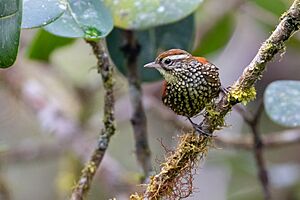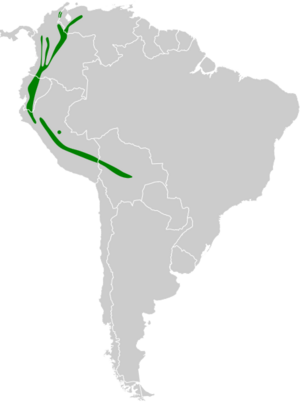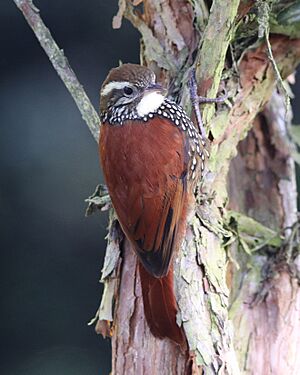Pearled treerunner facts for kids
Quick facts for kids Pearled treerunner |
|
|---|---|
 |
|
| Conservation status | |
| Scientific classification | |
| Genus: |
Margarornis
|
| Species: |
squamiger
|
 |
|
The pearled treerunner (Margarornis squamiger) is a small bird that belongs to the ovenbird family, Furnariidae. You can find this bird in countries like Bolivia, Colombia, Ecuador, Peru, and Venezuela. It might also live in Argentina.
Contents
About the Pearled Treerunner
Bird Types
The pearled treerunner has three main types, called subspecies. They are M. s. squamiger, M. s. perlatus, and M. s. peruvianus. These types are slightly different from each other.
What It Looks Like
This bird is about 15 to 16 centimeters (6 inches) long. It weighs between 14 and 19 grams (about half an ounce). Both male and female birds look the same.
The pearled treerunner has a yellowish stripe above its eye. This stripe goes all the way to the back of its neck. It has reddish-brown feathers on its back and tail. Its tail feathers look a bit spiky at the ends.
Its throat is bright yellow. The chest and belly have a reddish background. They are covered with yellowish spots that have dark outlines. These spots become less clear further down its body. Its legs and feet are brownish-gray. Young birds have slightly different patterns on their chests.
The subspecies M. s. peruvianus looks a bit different. It has a paler yellow stripe above its eye. Its crown, which is the top of its head, is olive-brown. It also has fewer spots on its belly. The M. s. perlatus subspecies is similar to peruvianus. But it has a whiter stripe above its eye and whiter spots on its belly.
Where It Lives
Its Home Countries
The different types of pearled treerunners live in specific areas:
- M. s. perlatus: Found from western Venezuela, through Colombia, and into northern Peru.
- M. s. peruvianus: Lives in the Andes mountains of Peru, south of the Marañón River.
- M. s. squamiger: Found in the Andes from southern Peru down into Bolivia.
There was one sighting in northern Argentina. So, scientists think it might live there too.
Its Favorite Places
The pearled treerunner mostly lives in mountain forests. These are often evergreen forests, meaning the trees stay green all year. It also likes "elfin forests," which are dense, stunted forests. It prefers areas with lots of moss and plants growing on trees. These birds usually live at high elevations. They are found between 2,500 and 3,500 meters (8,200 to 11,500 feet) high. Sometimes, they can be seen as low as 1,500 meters (4,900 feet) or as high as 3,800 meters (12,500 feet).
How It Behaves
Movement
The pearled treerunner stays in the same area all year. It does not migrate.
Feeding Habits
This bird eats many kinds of small insects and spiders. It usually hunts for food in pairs or small groups. Often, it joins other bird species in mixed feeding flocks. It mostly looks for food from the middle to the top of the forest trees.
The pearled treerunner is very agile. It climbs up tree trunks and along branches. It uses its spiky tail to help it hold on. It finds its prey mostly in moss and other plants growing on trees. Sometimes, it hangs upside down to find food. It also looks for food on tree bark and dead leaves.
Reproduction
Scientists are still learning about the pearled treerunner's breeding season. It seems to lay eggs from December to June. These birds are thought to stay with one partner for life. They build a ball-shaped nest out of moss. The nest has an entrance on the side. They place their nests under a tree branch or a rock. Not much else is known about how they raise their young.
Sounds It Makes
The pearled treerunner is not a very loud bird. Its song is a fast series of high-pitched "tick" notes. Its calls include a single high-pitched "tick" or "tsit." It also makes a short trill sound, like "trrrt-trrrt."
Its Conservation Status
The IUCN (International Union for Conservation of Nature) says the pearled treerunner is a species of "Least Concern." This means it is not currently in danger of disappearing. It lives across a very large area. Even though its exact population size is unknown, scientists believe it is stable. There are no major threats to this bird right now. It is considered fairly common in its habitat. It can even live in forests that have been slightly changed by humans.
Images for kids





